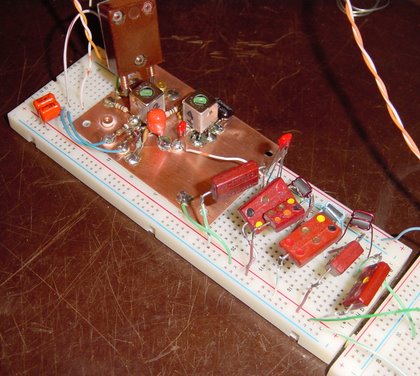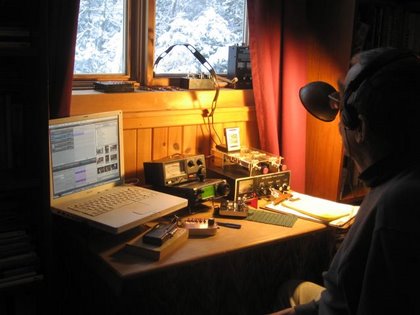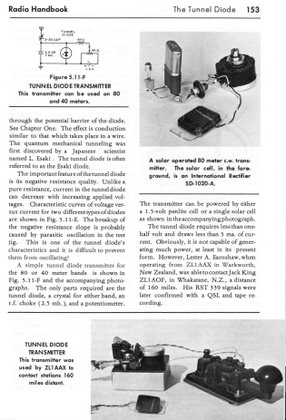"Synchrony"
Schematic here
It's now clear to me why nearly all of the 1960's tunnel diode novelty transmitters were designed for phone rather than CW. Trying to keep a tunnel diode oscillator frequency-locked to a quartz crystal - while drawing staccato power from it - is akin to balancing a pea on your knife while jumping on a pogo stick! The problem is associated with the nature of non-linear oscillators in general. That is, the bias required for a reasonable output power in a keyed oscillator is higher than the bias needed for reliable frequency-locking to a quartz crystal; the circuit exhibits hysteresis.
My solution to this problem is to employ a two-stage transmitter. The crystal-controlled exciter oscillates continuously under a light load. A small sample of the exciter energy is required to reliably synchronize the keyed, higher-power, heavily-loaded, LC oscillator to the exciter operating frequency. This circuit resembles a classic, master-oscillator-power-amplifier (or MOPA) transmitter; however, it's more accurately described as a master-oscillator, synchronized power oscillator circuit. I've named this two-stage design, "Synchrony."
AA1MY has kindly made several recordings of my signal available here
Contact log from my QTH in Roxbury, Vermont
Date Station QTH My RST Miles/Watt Comments
1/10/08 AA1MY Bethel, ME 539 471k Sked
1/11/08 AA1MY Bethel, ME 539 471k Contact "on and off" for 45 minute duration
1/14/08 AA1MY Bethel, ME 539 471k Same as above; 2 hour duration
1/15/08 AA1MY Bethel, ME 439 471k QSO marking the 50th anniversary of Leo Esaki's 1958 paper
1/16/08 AA1MY Bethel, ME 549 471k Best QSB peak yet
1/17/08 AA1MY Bethel, ME 329 500k New two-stage transmitter: "Synchrony"
1/20/08 AA1MY Bethel, ME 349 500k
1/21/08 AA1MY Bethel, ME 549 471k
1/24/08 AA1MY Bethel, ME 229 833k 100miles/120uW
2/05/08 AA1MY Bethel, ME 229 833k All tunnel diode station used at AA1TJ
2/07/08 AA1MY Bethel, ME 229 1052k 95uW; Surpassed the million mile per watt mark
Confirmed Beacon Reception Reports
1/28/08 AA1MY Bethel, ME 329 833k "Grail"
1/28/08 N1RX Newport, NH 429 475k "Grail"
2/07/08 AA1MY Bethel, ME 229 1052k "Orion" 95uW
2/09/08 KM1Z Burlington, VT 308k "Orion"
2/09/08 AA1MY Bethel, ME 339 833k "Amore"
3/08/08 AA1MY Bethel, ME 249 2381k "Esaki" 42uW
Seab, AA1MY, has repeatedly amazed me with his ability to pull my weak signal out of the noise. He uses an IC706-IIG and a homebrew tuner. Ladder-line drives a center fed, 176 foot inverted-vee antenna with the center located at a height of 50 feet. Here's a photo taken of Seab during one of our QSOs.
Finally, here's the page that fired my enthusiasm for tunnel diode transmitters when I was fourteen years old. It's taken from The Transistor Radio Handbook, 1st Ed., 1963, by D. Stoner, W6TNS, and L. Earnshaw, ZL1AAX


